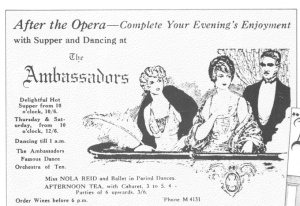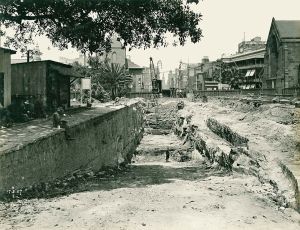There are quite a few that are hiding from me. Images I’m talking about. After a few weeks of dogged research I have finally unearthed the photo above courtesy of Mike Sutcliffe’s article from This Australia 1986. I know the writing is small but according to the ad “Delightful hot supper from 10 o’clock…dancing until 1am…Order drinks before 6pm.”
Now that last is a vital piece of information – the ridiculous six o’clock closing which, of course, bred the sly grog shops and the illegal sale of liquor at many locations, including The Ambassadors. I have just this week finished writing about a raid on the cafe and have now turned my attention to other cafes in the area.
Jack Lindsay, Norman Lindsay’s son, writes of Mockbells: “I sat over my eked-out coffee and dozed amid the pseuod-moorish decorations almost obliterated by smoke, age, damp and their own insignificance.” I know from my research that there were a few over the years. One in Castlereagh Street (possibly Jack’s). Another in the Imperial Arcade in 1902. In 1897 a Mockbells cafe had a general meeting of the Society of Artists. That’s the earliest mention I have found. The latest is 1948 in an article: “Mockbell’s, Ltd., has agreed to sell six of the company’s seven city restaurants to a new company to be called Mockbell’s Pty. Ltd.” And after that they disappear. As for pictures? I haven’t found one! If anyone has any I would love to see them.
I have also been unable to find several other cafe/restaurants of Sydney in 1921-1926 that Jack writes about. There is the Cambridge, the Hungarian cafe, the Moana, the Roma and Burt’s Milk Bar. I have also not been able to unearth a picture of Amendola’s wine bar in Wilmott Street which later became Cafe La Boheme. Or Pelligrini’s. I’m still hopeful about these last two. And will post again if I find any of the cafes mentioned.
If however you are looking for a Sydney cafe frequented twenty odd years later by bohemians – journalists, writers and artists – well you are in luck! Below is one of many wonderful photos of the Lincoln Coffee House 1948-1951.
 This image is courtesy of the State Library of New South Wales on Flickr. If you know of any photos of the above cafes and restaurants of Sydney in the Twenties, I would love to hear from you. Here’s hoping!
This image is courtesy of the State Library of New South Wales on Flickr. If you know of any photos of the above cafes and restaurants of Sydney in the Twenties, I would love to hear from you. Here’s hoping!


